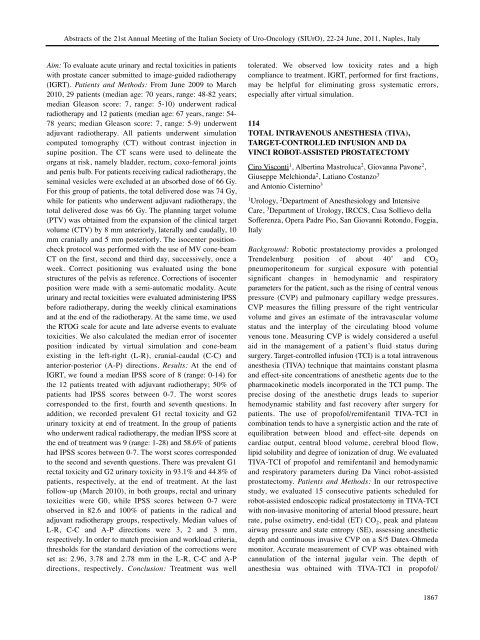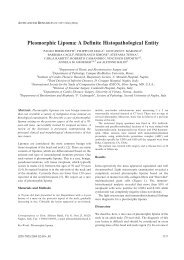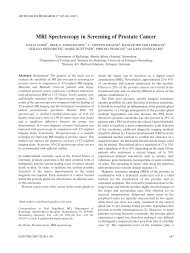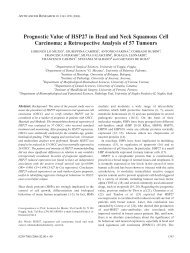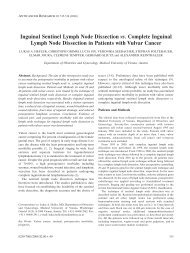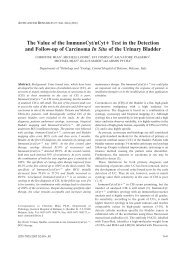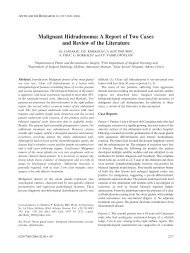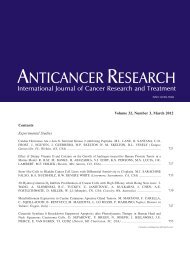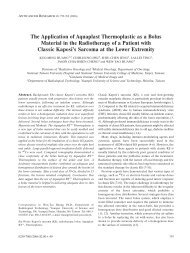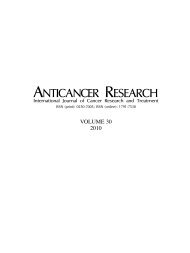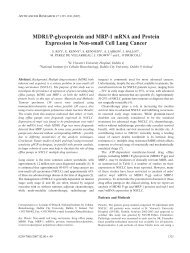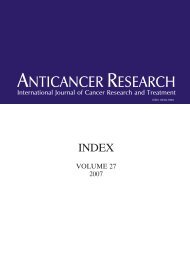ABSTRACTS OF THE 21st ANNUAL MEETING OF THE ITALIAN ...
ABSTRACTS OF THE 21st ANNUAL MEETING OF THE ITALIAN ...
ABSTRACTS OF THE 21st ANNUAL MEETING OF THE ITALIAN ...
You also want an ePaper? Increase the reach of your titles
YUMPU automatically turns print PDFs into web optimized ePapers that Google loves.
Abstracts of the <strong>21st</strong> Annual Meeting of the Italian Society of Uro-Oncology (SIUrO), 22-24 June, 2011, Naples, Italy<br />
Aim: To evaluate acute urinary and rectal toxicities in patients<br />
with prostate cancer submitted to image-guided radiotherapy<br />
(IGRT). Patients and Methods: From June 2009 to March<br />
2010, 29 patients (median age: 70 years, range: 48-82 years;<br />
median Gleason score: 7, range: 5-10) underwent radical<br />
radiotherapy and 12 patients (median age: 67 years, range: 54-<br />
78 years; median Gleason score: 7, range: 5-9) underwent<br />
adjuvant radiotherapy. All patients underwent simulation<br />
computed tomography (CT) without contrast injection in<br />
supine position. The CT scans were used to delineate the<br />
organs at risk, namely bladder, rectum, coxo-femoral joints<br />
and penis bulb. For patients receiving radical radiotherapy, the<br />
seminal vesicles were excluded at an absorbed dose of 66 Gy.<br />
For this group of patients, the total delivered dose was 74 Gy,<br />
while for patients who underwent adjuvant radiotherapy, the<br />
total delivered dose was 66 Gy. The planning target volume<br />
(PTV) was obtained from the expansion of the clinical target<br />
volume (CTV) by 8 mm anteriorly, laterally and caudally, 10<br />
mm cranially and 5 mm posteriorly. The isocenter positioncheck<br />
protocol was performed with the use of MV cone-beam<br />
CT on the first, second and third day, successively, once a<br />
week. Correct positioning was evaluated using the bone<br />
structures of the pelvis as reference. Corrections of isocenter<br />
position were made with a semi-automatic modality. Acute<br />
urinary and rectal toxicities were evaluated administering IPSS<br />
before radiotherapy, during the weekly clinical examinations<br />
and at the end of the radiotherapy. At the same time, we used<br />
the RTOG scale for acute and late adverse events to evaluate<br />
toxicities. We also calculated the median error of isocenter<br />
position indicated by virtual simulation and cone-beam<br />
existing in the left-right (L-R), cranial-caudal (C-C) and<br />
anterior-posterior (A-P) directions. Results: At the end of<br />
IGRT, we found a median IPSS score of 8 (range: 0-14) for<br />
the 12 patients treated with adjuvant radiotherapy; 50% of<br />
patients had IPSS scores between 0-7. The worst scores<br />
corresponded to the first, fourth and seventh questions. In<br />
addition, we recorded prevalent G1 rectal toxicity and G2<br />
urinary toxicity at end of treatment. In the group of patients<br />
who underwent radical radiotherapy, the median IPSS score at<br />
the end of treatment was 9 (range: 1-28) and 58.6% of patients<br />
had IPSS scores between 0-7. The worst scores corresponded<br />
to the second and seventh questions. There was prevalent G1<br />
rectal toxicity and G2 urinary toxicity in 93.1% and 44.8% of<br />
patients, respectively, at the end of treatment. At the last<br />
follow-up (March 2010), in both groups, rectal and urinary<br />
toxicities were G0, while IPSS scores between 0-7 were<br />
observed in 82.6 and 100% of patients in the radical and<br />
adjuvant radiotherapy groups, respectively. Median values of<br />
L-R, C-C and A-P directions were 3, 2 and 3 mm,<br />
respectively. In order to match precision and workload criteria,<br />
thresholds for the standard deviation of the corrections were<br />
set as: 2.96, 3.78 and 2.78 mm in the L-R, C-C and A-P<br />
directions, respectively. Conclusion: Treatment was well<br />
tolerated. We observed low toxicity rates and a high<br />
compliance to treatment. IGRT, performed for first fractions,<br />
may be helpful for eliminating gross systematic errors,<br />
especially after virtual simulation.<br />
114<br />
TOTAL INTRAVENOUS ANES<strong>THE</strong>SIA (TIVA),<br />
TARGET-CONTROLLED INFUSION AND DA<br />
VINCI ROBOT-ASSISTED PROSTATECTOMY<br />
Ciro Visconti1 , Albertina Mastroluca2 , Giovanna Pavone2 ,<br />
Giuseppe Melchionda2 , Latiano Costanzo3 and Antonio Cisternino3 1Urology, 2Department of Anesthesiology and Intensive<br />
Care, 3Department of Urology, IRCCS, Casa Sollievo della<br />
Sofferenza, Opera Padre Pio, San Giovanni Rotondo, Foggia,<br />
Italy<br />
Background: Robotic prostatectomy provides a prolonged<br />
Trendelenburg position of about 40˚ and CO 2<br />
pneumoperitoneum for surgical exposure with potential<br />
significant changes in hemodynamic and respiratory<br />
parameters for the patient, such as the rising of central venous<br />
pressure (CVP) and pulmonary capillary wedge pressures.<br />
CVP measures the filling pressure of the right ventricular<br />
volume and gives an estimate of the intravascular volume<br />
status and the interplay of the circulating blood volume<br />
venous tone. Measuring CVP is widely considered a useful<br />
aid in the management of a patient’s fluid status during<br />
surgery. Target-controlled infusion (TCI) is a total intravenous<br />
anesthesia (TIVA) technique that maintains constant plasma<br />
and effect-site concentrations of anesthetic agents due to the<br />
pharmacokinetic models incorporated in the TCI pump. The<br />
precise dosing of the anesthetic drugs leads to superior<br />
hemodynamic stability and fast recovery after surgery for<br />
patients. The use of propofol/remifentanil TIVA-TCI in<br />
combination tends to have a synergistic action and the rate of<br />
equilibration between blood and effect-site depends on<br />
cardiac output, central blood volume, cerebral blood flow,<br />
lipid solubility and degree of ionization of drug. We evaluated<br />
TIVA-TCI of propofol and remifentanil and hemodynamic<br />
and respiratory parameters during Da Vinci robot-assisted<br />
prostatectomy. Patients and Methods: In our retrospective<br />
study, we evaluated 15 consecutive patients scheduled for<br />
robot-assisted endoscopic radical prostatectomy in TIVA-TCI<br />
with non-invasive monitoring of arterial blood pressure, heart<br />
rate, pulse oximetry, end-tidal (ET) CO 2, peak and plateau<br />
airway pressure and state entropy (SE), assessing anesthetic<br />
depth and continuous invasive CVP on a S/5 Datex-Ohmeda<br />
monitor. Accurate measurement of CVP was obtained with<br />
cannulation of the internal jugular vein. The depth of<br />
anesthesia was obtained with TIVA-TCI in propofol/<br />
1867


